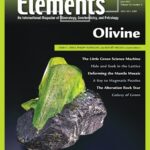
Olivine, June 2023, Vol. 19, No. 3
June 28, 2024
Elements Joint Society Calendar (2025–2026)
July 17, 2024Metamorphic Duality in SW Japan—The Sanbagawa-Ryoke Classic Example of Paired Metamorphism, April 2024, Vol. 20, No. 2
$20.00
Subduction, where one plate dives beneath another, controls longterm wholeEarth cycling of rocks, fluids and energy. Plates subduct faster than they heat up, making them the coldest parts of the Earth’s interior.
Metamorphic Duality in SW Japan—The Sanbagawa-Ryoke Classic Example of Paired Metamorphism
April 2024, Vol. 20, No. 2
Subduction, where one plate dives beneath another, controls longterm wholeEarth cycling of rocks, fluids and energy. Plates subduct faster than they heat up, making them the coldest parts of the Earth’s interior. Fluids released from these cold plates rise into hotter overlying rocks forming magma that feeds surface volcanism. Cold deep conditions associated with subduction complemented by hot shallow conditions under volcanic arcs are reflected in the presence of pairs of metamorphic belts representing sites of ancient subduction—the Cretaceous SanbagawaRyoke metamorphic pair of Japan is a premier example. Estimates of pressure, temperature, the age and duration of metamorphism, and the tectonic framework in which metamorphism took place help us develop quantitative models both for the evolution of SW Japan and subduction systems in general.
Why You’ll Love Elements Magazine:
- Expert Contributors: Articles written by renowned researchers in the field of geoscience.
- Engaging Content: Join a community of readers who are passionate about Elements.
- Exceptional Quality: Each issue is printed on high-quality paper with stunning visuals and detailed illustrations that bring complex scientific concepts to life.
Order your copy of the April 2024 issue of Elements magazine today and explore metamorphic duality in SW Japan—the Sanbagawa-Ryoke classic example of paired metamorphism.
Related products
-
Large Igneous Provinces: Origin And Environmental Consequences, December 2005, Vol. 1, No. 5
$20.00Large igneous provinces record major outpourings of igneous rocks, both on the continents and in ocean basins. Their origin is still vigorously disputed, with models invoking mantle plumes, thermal effects of the lithosphere, and meteorite impacts.
-
Toxic Metals In The Environment: The Role Of Surfaces, September 2005, Vol. 1, No. 4
$20.00Metals are prevalent in the environment. They are derived from both natural and anthropogenic sources.
-
Supervolcanoes, February 2008, Vol. 4, No. 1
$20.00Explosive super-eruptions from large volume, shallow magma systems lead to enormous and devastating pyroclastic flows, the formation of gigantic collapse calderas, and deposition of volcanic ash over continent-sized areas. Recognition that future eruptions from these “supervolcanoes” will undoubtedly have severe impacts on society—and perhaps on life itself—has led to recent public and media interest.




